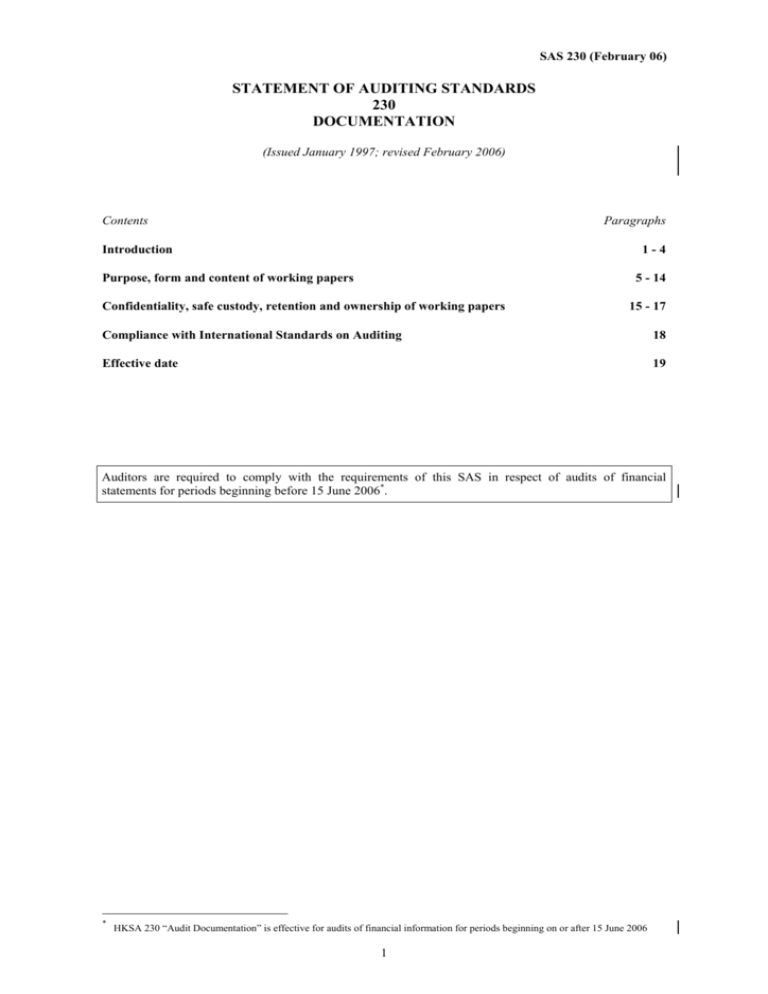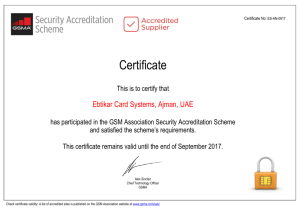STATEMENT OF AUDITING STANDARDS 230 DOCUMENTATION
advertisement

SAS 06) SAS230 230(February (January 97) STATEMENT OF AUDITING STANDARDS 230 DOCUMENTATION (Issued January 1997; revised February 2006) Contents Paragraphs Introduction 1-4 Purpose, form and content of working papers 5 - 14 Confidentiality, safe custody, retention and ownership of working papers 15 - 17 Compliance with International Standards on Auditing 18 Effective date 19 Auditors are required to comply with the requirements of this SAS in respect of audits of financial statements for periods beginning before 15 June 2006*. * HKSA 230 “Audit Documentation” is effective for audits of financial information for periods beginning on or after 15 June 2006 1 SAS 230 (January 97) STATEMENT OF AUDITING STANDARDS 230 DOCUMENTATION Statements of Auditing Standards (SASs) are to be read in the light of SAS 010 "The scope and authority of auditing pronouncements". In particular, they contain basic principles and essential procedures, (auditing standards), indicated by paragraphs in bold italic type, with which auditors are required to comply in the conduct of any audit including those of companies applying section 141D of the Companies Ordinance. SASs also include explanatory and other material which is designed to assist auditors in interpreting and applying auditing standards. Introduction 1. The purpose of this Statement of Auditing Standards (SAS) is to establish standards and provide guidance regarding documentation of audit evidence in the context of the audit of financial statements. 2. Auditors should document matters which are important in providing evidence to support the audit opinion. (SAS 230.1) 3. "Documentation" means the working papers prepared by and for, or obtained and retained by the auditors in connection with the performance of the audit. 4. "Working papers" are a record of the planning and performance of the audit, the supervision and review of the audit work, and the audit evidence resulting from the audit work performed to support the auditors' opinion. Working papers may be in the form of data stored on paper, film, electronic media or other media which are capable of being reproduced in a legible form. Working papers support, amongst other things, the statement in the auditors' report as to the auditors' compliance or otherwise with SASs, and thus record compliance with SASs to the extent that this is important in supporting their report. Purpose, form and content of working papers 5. Auditors should prepare working papers which are sufficiently complete and detailed to provide an overall understanding of the audit to another experienced auditor. (SAS 230.2) 6. Auditors should record in working papers the planning, the nature, timing and extent of the audit procedures performed, the results thereof, and the conclusions drawn from the audit evidence obtained. (SAS 230.3) 7. Working papers would include the auditors' reasoning on all significant matters which require the exercise of judgement, together with the auditors' conclusion thereon. In areas involving difficult questions of principle or judgement, working papers would record the relevant facts that were known by the auditors at the time the conclusions were reached. 8. The extent of working papers is a matter of professional judgement since it is neither necessary nor practical to document every matter the auditors consider. Auditors base their judgement as to the extent of working papers upon what would be necessary to provide an experienced auditor, with no previous connection with the audit, with an understanding of the work performed and the basis of the decisions taken. However, even then, that experienced auditor may only be able to obtain a comprehensive understanding of all aspects of the audit by discussing them with the auditors who prepared them. 2 SAS 230 (January 97) 9. The form and content of working papers are affected by matters such as the a. nature of the engagement; b. form of the auditors' report; c. nature and complexity of the business; d. nature and condition of the entity's accounting and internal control systems; e. needs in the particular circumstances for direction, supervision and review of work performed by assistants; and f. specific audit methodology and technology used in the course of the audit. 10. Working papers are designed and organised to meet the circumstances and the auditors' needs for each individual audit. The use of standardised working papers (for example, checklists, specimen letters, standard organisation of working papers) may improve the efficiency with which such working papers are prepared and reviewed. They facilitate the delegation of work while providing a means to control its quality. However, it is never appropriate to follow mechanically a standard approach to the conduct and documentation of the audit without regard to the need to exercise professional judgement. 11. To improve audit efficiency, the auditors may utilise schedules, analyses and other documentation prepared by the entity. In such circumstances, the auditors would need to be satisfied that those materials have been properly prepared. 12. Working papers ordinarily include: a. information concerning the legal and organisational structure of the entity; b. extracts or copies of important legal documents, agreements and minutes; c. information concerning the industry, economic environment and legislative environment within which the entity operates; d. evidence of the planning process including the overall audit plan, the audit programme and any changes thereto; e. evidence of the auditors' understanding of the accounting and internal control systems; f. evidence of inherent and control risk assessments and any revisions thereof; g. evidence of the auditors' consideration of the work of internal auditing and conclusions reached; h. analyses of transactions and balances; i. analyses of significant ratios and trends; j. a record of the nature, timing and extent of audit procedures performed and the results of such procedures; k. evidence that the work performed by assistants was supervised and reviewed; l. an indication as to who performed the audit procedures and when they were performed; 3 SAS 230 (February 06) SAS 230 (January 97) m. details of procedures applied regarding components whose financial statements are audited by other auditors; n. copies of communications with other auditors, experts and other third parties; o. copies of letters or notes concerning audit matters communicated to or discussed with the entity, including the terms of the engagement and material weaknesses in internal control; p. letters of representation received from the entity; q. conclusions reached by the auditors concerning significant aspects of the audit, including how exceptions and unusual matters, if any, disclosed by the auditors' procedures were resolved or treated; and r. copies of the financial statements and auditors' report. 13. Working papers typically record when and by whom audit procedures are undertaken and when and by whom they are reviewed. A written record of points raised during the review of working papers need not be retained providing the working papers demonstrate evidence of the extent of the review process and are updated to record the resolution of any significant matters noted. 14. In the case of recurring audits, some working paper files may be classified as "permanent" audit files which are updated with new information of continuing importance as distinct from "current" audit files which contain information relating primarily to the audit of a single period. Confidentiality, safe custody, retention and ownership of working papers 15. Auditors should adopt appropriate procedures for maintaining the confidentiality and safe custody of the working papers. (SAS 230.4) 16. There are no specific statutory requirements in Hong Kong regarding the period of retention of audit working papers. Auditors exercise judgement to determine the appropriate period of retention bearing in mind possible needs of their client, for example that audited information may need to be included in a prospectus at some future date, and their own needs, including any regulatory requirements. Prior to their destruction, auditors consider whether there is likely to be a need to refer to them again. 17. Working papers are the property of the auditors. Although portions of or extracts from the working papers may be made available to the entity at the discretion of the auditors, they are not a substitute for the entity's accounting records. Compliance with International Standards on Auditing 18. With the exception that this SAS does not contain an auditing standard on the retention of working papers, compliance with the auditing standards contained in this SAS ensures compliance in all material respects with the basic principles and essential procedures in International Standard on Auditing 230 "Documentation". Effective date 19. This SAS is effective for audits of financial statements for periods beginning before 15 June 2006. 4








